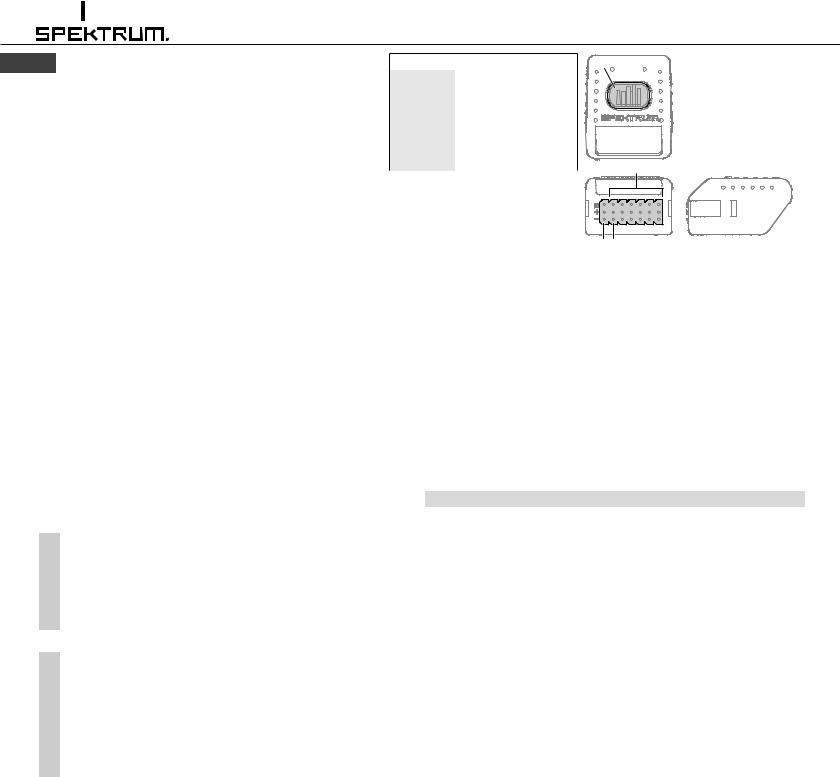Spektrum AR620 User Manual

|
|
|
|
|
|
|
AR620 Receiver Information // Informations de récepteur AR620 |
SPMAR620 |
|
|
|
|
|
|
|
||
|
|
|
|
|
|
|
||
|
|
|
|
|
|
|
EN Your Spektrum™ transmitter was packaged with the Spektrum AR620 full range receiver. The transmitter manual states the AR610 is included. Follow this document for
information regarding features and binding of the included AR620 receiver. The AR620 offers:
•Antenna-less design
•End-pin layout for cleaner installation
•Large bind-button eliminates the need for a separate bind plug
•Integrated fl ight log and receiver voltage telemetry with fl y-by range when used with a telemetry capable Spektrum transmitter
•Two options for failsafe programming, SmartSafe™ + Hold Last or Preset failsafe
Spektrum AR620 Receiver
Type |
6-Channel Sport Receiver |
Dimensions |
L 32.1 × W 26.4 × H 17.9mm |
Antenna |
Internal |
Channels |
6 |
Weight |
8g |
Band |
2.4GHz |
Voltage Range |
3.5–9V |
A |
A: Bind Button |
|
B: Battery port |
||
|
 C: Servo ports (1-6)
C: Servo ports (1-6)
 D: 1/DATA: Servo port 1 and DATA
D: 1/DATA: Servo port 1 and DATA
C
B D |
Installation
Install the receiver in the normal position recommended by the airplane’s manufacturer. Double-sided tape or foam can be used to secure the receiver in place.
Binding
The AR620 receiver must be bound to the transmitter before they will operate together. Binding is the process of teaching the receiver the specifi c code of the transmitter so it will only connect to that specifi c transmitter. The failsafe programming option is set during the binding process.
In the unlikely event the radio link is lost during use, the receiver will drive all channels to their programmed failsafe positions.
Failsafe Programming Options:
SmartSafe™ + Hold Last failsafe
If loss of signal occurs, SmartSafe™ technology moves the throttle channel to its preset failsafe position (low throttle) that was set during binding. All other channels hold their last position. When the receiver detects signal from the transmitter, normal aircraft operation resumes.
Preset failsafe
Preset failsafe is ideal for sailplanes, allowing the aircraft to automatically dethermalize if the signal is lost. With preset failsafe, all channels go to their preset failsafe positions if the signal is lost, preventing a fl yaway. When the receiver detects signal from the transmitter, normal aircraft operation resumes.
To bind in SmartSafe + Hold Last failsafe mode:
1 |
Lower the throttle on the transmitter |
2 |
Push and hold receiver bind button |
3 |
Power on receiver |
4 |
Release the bind button when the receiver enters bind mode, indicated by a fl ashing LED on |
|
the receiver |
5 |
Follow your transmitter manual to place the transmitter in bind mode. The transmitter and |
|
receiver are bound when the LED on the receiver glows solid. |
To bind in Preset failsafe mode
1 |
Move all sticks and switches on the transmitter to the desired failsafe positions |
2 |
Push and hold the receiver bind button |
3 |
Power on the receiver |
4 |
Release the bind button when the receiver enters bind mode, indicated by a fl ashing LED on |
|
the receiver |
5 |
Push and hold the receiver bind button again |
6 |
Follow your transmitter manual to place the transmitter in bind mode. The transmitter and |
|
receiver are bound when the LED on the receiver glows solid. |
7 |
Release the bind button |
FCC Information
FCC ID: BRWTPSPMAR620
This equipment has been tested and found to comply with the limits for a Class B digital device, pursuant to part 15 of the FCC Rules. These limits are designed to provide reasonable protection against harmful interference in a residential installation. This equipment generates, uses and can radiate radio frequency energy and, if not installed and used in accordance with the instructions, may cause harmful interference to radio communications.
However, there is no guarantee that interference will not occur in a particular installation. If this equipment does cause harmful interference to radio or television reception, which can be determined by turning the equipment off and on, the user is encouraged to try to correct the interference by one or more of the following measures:
•Reorient or relocate the receiving antenna.
•Increase the separation between the equipment and receiver.
•Connect the equipment to an outlet on a circuit different from that to which the receiver is connected.
•Consult the dealer or an experienced radio/TV technician for help.
This device complies with part 15 of the FCC rules. Operation is subject to the following two conditions: (1) This device may not cause harmful interference, and (2) this device must accept any interference received, including interference that may cause undesired operation.
NOTICE: Modifi cations to this product will void the user’s authority to operate this equipment.
This product contains a radio transmitter with wireless technology which has been tested and found to be compliant with the applicable regulations governing a radio transmitter in the 2.400GHz to 2.4835GHz frequency range.
IC Information
IC: 6157A-TPSPMAR620
This device complies with Industry Canada license-exempt RSS standard(s). Operation is subject to the following two conditions: (1) this device may not cause interference, and (2) this device must accept any interference, Including interference that may cause undesired operation of the device.
